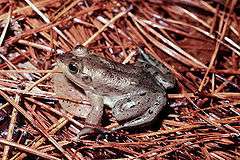Pig frog
| Pig frog | |
|---|---|
 | |
| Scientific classification | |
| Kingdom: | Animalia |
| Phylum: | Chordata |
| Subphylum: | Vertebrata |
| Class: | Amphibia |
| Order: | Anura |
| Family: | Ranidae |
| Genus: | Rana |
| Species: | R. grylio |
| Binomial name | |
| Rana grylio[1][2] Stejneger, 1901 | |
| Synonyms | |
| |
The pig frog (Rana grylio) is a species of aquatic frog found in the Southeastern United States, from South Carolina to Texas. Some sources also refer to it as the lagoon frog or the southern bullfrog.
Taxonomy
Norwegian-American naturalist Leonhard Stejneger described the pig frog in 1901, and it still bears its original name.
Description
The pig frog is green or grey-green in color, with brown or black blotching. It has fully webbed feet, a sharply pointed nose, and large tympana (eardrums). It is easily mistaken for various other species of the genus Rana, with which it shares its geographic range, including the American bullfrog (Rana catesbeiana). Pig frogs grow to a snout to vent length (SVL) of 3.25 to 5.5 in (8.3 to 14.0 cm).
Ecology and behavior
Almost entirely aquatic, they are found predominantly on the edges of lakes, or in cypress swamps and marshes that are heavy with vegetation. They are nocturnal. Their pig-like grunts can be heard during the warm months of the year.
Diet
Their primary diet is crayfish, but like most bullfrogs, they will consume almost anything they can swallow, including insects, fish, and other frogs.
Reproduction
Breeding takes place from spring through to summer. Eggs are laid in large masses of up to 10,000 at a time on the surface of the water. This species gets its common name from the call males use to attract females, which sounds somewhat like a pig's grunt.
Conservation status
The pig frog holds no particular conservation status and is relatively common in its range. The species has been introduced and established itself in China, Andros Island and New Providence Island in the Bahamas, as well as Puerto Rico.
Pig frogs have been reported to be raised for food by Chinese farmers, along with bullfrogs.[3]
Footnotes
- ↑ Hillis 2007.
- ↑ Hillis & Wilcox 2005.
- ↑ Court receives warning letter from local authorities in frog compensation case, based on June 2010 newspaper articles.
References
- Frogs & Toads of Georgia: Pig Frog
- Animal Diversity Web: Rana grylio
- Amphibian Species of the World: Rana grylio
- Hammerson et al. (2004). Rana grylio. 2006. IUCN Red List of Threatened Species. IUCN 2006. www.iucnredlist.org. Retrieved on 10 May 2006. Database entry includes a range map and a brief justification of why this species is of least concern.
- Hillis, D.M., & Wilcox, T.P. (2005). Phylogeny of the New World true frogs (Rana). Mol. Phylogenet. Evol. 34 (2): 299–314. doi:10.1016/j.ympev.2004.10.007 PDF fulltext.
- Hillis, D.M. (2007). Constraints in naming parts of the Tree of Life. Mol. Phylogenet. Evol. 42: 331–338.
- Stejneger L. 1901. A New Species of Bullfrog from Florida and the Gulf Coast. Proc. United States Nat. Mus. 24: 211-215. (Rana grylio, new species).
| Wikimedia Commons has media related to Pig frog. |
| Wikispecies has information related to: Pig frog |
